What is a Decentralized Autonomous Organization? (DAO)
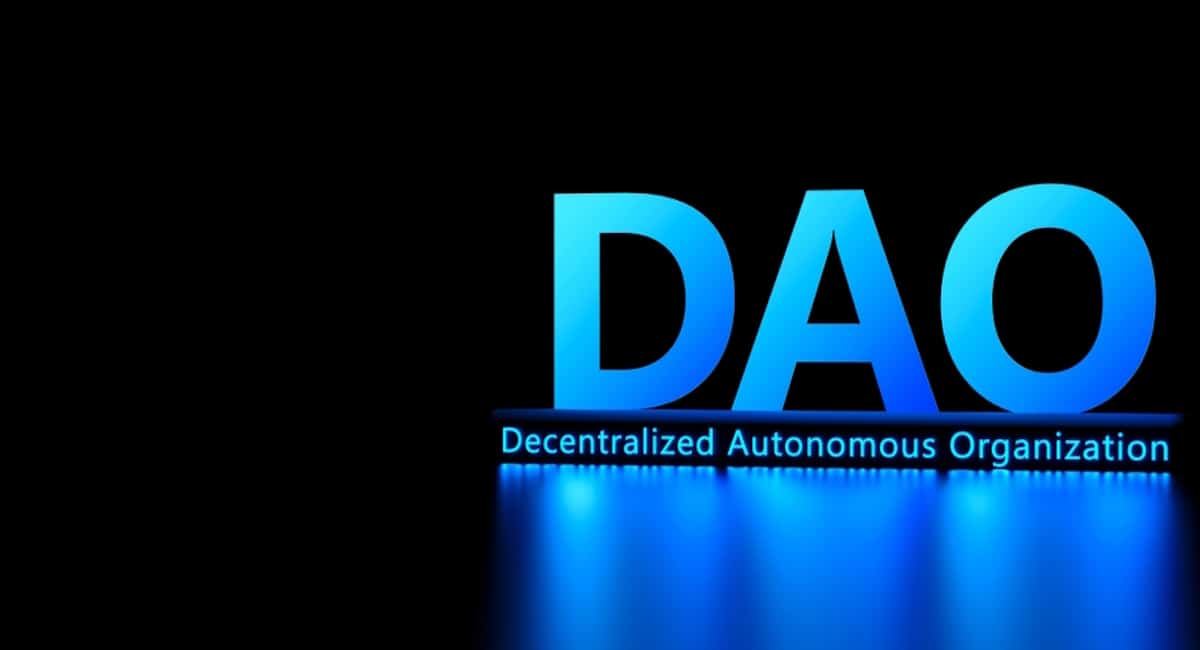
If you’re asking ‘what is a DAO?‘ you’re not alone. A Decentralized Autonomous Organization, also called a DAO, is a group that operates without a management team or centralized governance to support the common goals of the group. DAOs can include investment groups, donation organizations, or the governance of blockchain projects.
A DAO structure allows communities, companies, or organizations to manage a treasury or project in a decentralized way through voting using tokens and smart contracts that run on the blockchain.
A Brief History of DAOs
The history of DAOs dates back to 2016 when the first DAO, aptly named The DAO, was formed. The DAO operated as a type of blockchain venture capital fund and an experiment in crowdfunding on the Ethereum network.
A token sale in which the community purchased tokens with ether (ETH) raised much more than expected. Initially, the group planned to raise $5 million to $10 million for an Ethereum project called Slock.it.
However, as enthusiasm for the initiative continued to build, the DAO ultimately raised $150 million. That staggering figure represented 15% of the entire supply of ether in the still-new Ethereum ecosystem.
That figure plays a big role in what happened next. Less than three months after The DAO’s launch, hackers utilized a reentry attack against the smart contracts to drain the fund. Simultaneously, white-hat hackers also used the same exploit to move funds to safe wallets, while many users used alternate methods to recover their funds.
Ultimately, the hacker escaped with 3.6 million ETH. In a still-contentious decision, the Ethereum community proposed forking the chain to “undo” the hack. The fork, a split into two chains with different histories, came after a vote by the community in which 85% of the Ethereum community voted in support. The original chain still exists as Ethereum Classic.
DAOs After “The DAO”
Although The DAO hack set DAOs on a rocky start, DAOs are still active today, many with the simpler goal of governing protocols.
- Uniswap: UNI token holders vote on the governance of the Uniswap decentralized cryptocurrency exchange.
- Lido: The Lido protocol is the leading liquid staking protocol for Ethereum. The staking platform also supports Polygon staking and is governed by its community.
- Arbitrum: The launch of the ARB token coincided with the Arbitrum DAO, a decentralized organization that maintains a treasury to support the development of projects in the Arbitrum ecosystem and other purposes.
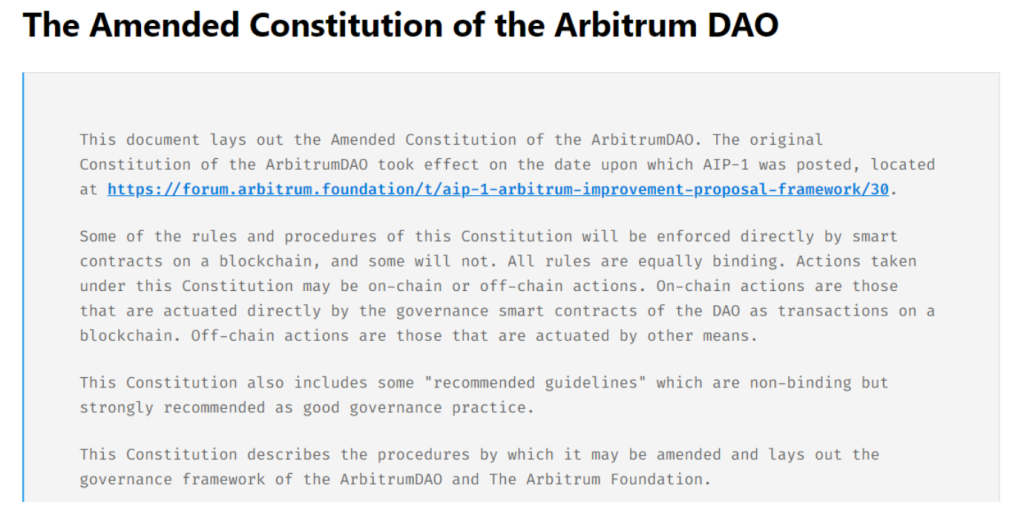
- MakerDAO: The Maker Protocol creates the DAI stablecoin, pegged to the US dollar and backed by leading cryptocurrencies like ETH and USDC. The protocol is governed by holders of the MKR token.
Other DAOs support specific causes or venture funding for new blockchain projects.
Social impact DAOs use decentralized governance to crowdfund in support of specific social issues.
- UkraineDAO
- Big Green DAO
- VitaDAO
Investment DAOs or Venture DAOs build a community around web3 projects, blockchain startups, and other investment opportunities, providing needed capital.
- SeedClub
- Syndicate DAO
- OrangeDAO
Single-purpose DAOs unite people with a single shared goal.
For example, the ConstitutionDAO was formed in 2021 to bid on a copy of the US Constitution at a Sotheby’s. As the DAO was unsuccessful in its bid, DAO members were offered the opportunity to get a refund.
NFT DAOs and Collector DAOs also allow fractional ownership of digital assets like NFTs (Non-fungible tokens).
For example, the PleasrDAO buys NFTS and then fractionalizes ownership using tokens that represent partial ownership.
Key Features of a DAO
A DAO differs from traditional organizations in several ways, with its key differences based on the use of smart contracts and DAO tokens.
DAOs are trustless, meaning DAO members don’t need to trust a leader, management team, or other authority. Instead, a DAO utilizes code (smart contracts) to account for governance votes, typically with one token representing one vote.
The “one token, one vote” system allows for decentralized decision-making, giving DAO members control of treasury usage or protocol management decisions.
Smart Contracts
Smart contracts are conditional computer programs that run on blockchain networks. In effect, they work like switches: if this happens, then do that. However, these switches can be complex, following a decision tree of if-thens to complete a transaction.
Blockchain smart contracts form the backbone of a DAO, allowing votes to be accounted for and, in some cases, automating the release of funds. Before reaching a final vote. DAOs often use several steps. The screenshot below from the Uniswap DAO details the governance process, including:
- A Temperature Check phase to gauge interest;
- A Consensus Check phase to continue discussion;
- And a Governance Proposal phase in which a qualified delegate proposes an on-chain vote powered by smart contracts.
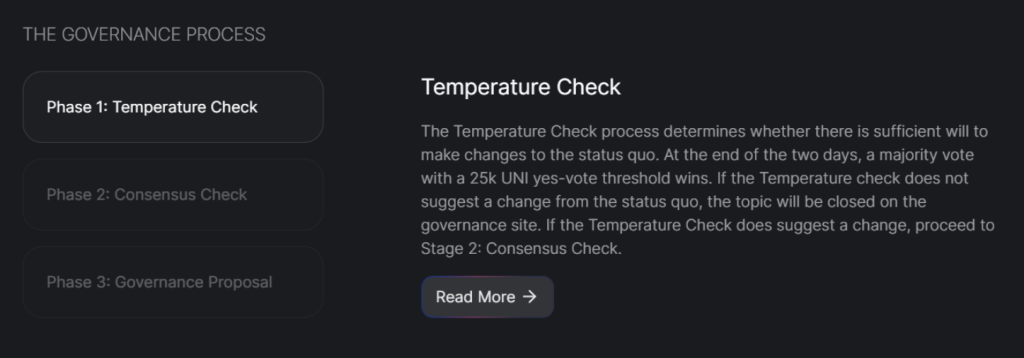
Governance Tokens
To vote on DAO proposals, DAO participants use governance tokens. In some cases, a governance token is the only official token for the protocol, as is the case with Uniswap (UNI), Aave (AAVE), and Arbitrum (ARB). These tokens have monetary value but do not power their respective protocols outside of their governance voting roles.
Some governance tokens also play a dual role as gas tokens. For example, Cardano’s ADA pays for transactions on the Cardano blockchain. However, ADA also doubles as a governance token.
Involvement of Token Holders
At the heart of it all, token holders decide the next moves for the DAO. A DAO is a true democracy, with one token equal to one vote, although tipped in favor of those with more tokens. The undue influence of wallets with larger token balances underscores the importance of broad participation in voting.
Still, the incentive likely remains the same — regardless of the number of tokens held. Governance tokens like ARB and UNI have monetary value. Holders of tokens are incentivized to act in the best interest of the protocol — and, by extension — the value of their tokens.
How to Create a DAO in 3 Steps
The expanding usage of DAOs means that groups, large or small, may want to explore the steps involved in creating a DAO.
As an overview, the process centers on three key steps: creating the smart contract, fundraising, and deploying to Mainnet on your blockchain of choice. Groups with a shared goal can create a DAO on any blockchain network that supports smart contracts, such as Ethereum or Solana, or even a layer 2 chain, such as Arbitrum.
As a prerequisite, consider defining the DAO with a constitution. This step allows you to examine the idea and process closely before investing in a smart contract, up next, or asking others to contribute to fundraising efforts for the DAO.
Also, consider whether you need a legal entity to hold the DAO. A “wrapped DAO” may help ensure compliance by holding the Decentralized Autonomous Organization within a traditional legal entity, such as an LLC.
Creating The Smart Contract
Earlier in the article, we discussed The DAO hack, in which hackers drained funding. Security and well-written code are essential to building your smart contract.
Before creating your contract, you’ll also need to consider tokenomics, including how many tokens your DAO creates and what those tokens enable them to do. Are they simply governance tokens, or do they represent ownership in a pool of assets?
The good news is that there’s no need to reinvent the wheel. Apps like Aragon can help you launch a DAO, including the design of smart contracts. Also, consider an audit for your smart contract using a reputable smart contract audit company. It’s important to remember that smart contracts cannot be modified once deployed.
Fundraising Through Token Issuance
The planned DAO will need funding for ongoing expenses as well as future goals. Initial fundraising can be done through token sales. Again, an app like Aragon can help you mint tokens and has helped launch over 7,000 DAOs to date.
Tokens also bring voting rights. Some DAOs use a delegate system, in which the full group users delegate their tokens to a smaller group of delegates.
Activating the Ecosystem on the Blockchain
To fully launch your Decentralized Autonomous Organization, the smart contract must be live on the blockchain. On the Ethereum network, for example, smart contracts execute in the Ethereum Virtual Machine (EVM), a secure environment on network nodes.
Code is law. Once the contract is deployed, it cannot be changed, and any further changes to the DAO itself must be by vote.
DAO Model vs Traditional Organizations
DAOs bring several advantages, particularly for those who favor decentralization and a certain level of privacy. However, both the DAO model and traditional organizational structure come with their advantages and disadvantages.
Forming a Decentralized Autonomous Organization can be a simple task, with the bulk of the time going into planning what your DAO will do and what value it offers to token holders. The launch itself can take minutes.
However, a token-based democracy like a DAO can be akin to herding cats. Many DAOs use a tiered decision-making process that brings well-supported ideas to a vote while leaving ideas with less support on the back burner.
The advantage comes in decentralization and transparency, as well as the ability to pursue endeavors that would be more difficult with traditional organizational structures. In particular, blockchain-based projects like NFT DAOs would likely find little support using traditional management structures.
By contrast, traditional organizations utilize stable and experienced management teams combined with clear goals and plans for execution. For some projects, traditional organizations may offer a better long-term solution.
What Can DAOs Be Used For?
Decentralized Autonomous Organizations can serve nearly any purpose, including causes typically in the realm of non-profit organizations, investment groups, or governance of decentralized apps and platforms.
- Governance: In its simplest form, a Decentralized Autonomous Organization offers a way to manage the DAO itself. What will the organization do next? The community decides, using tokens to vote.
- Venture Capital: The DAO, although ill-fated due to the hack, was best described as a venture capital DAO, providing seed funding to promising projects in the Ethereum ecosystem. Many smaller and simpler DAOs exist today, providing support to fledgling startups in niche markets.
- Decentralized Applications (dApps): The Decentraland DAO owns the smart contracts that run Decentraland’s metaverse platform.
- Decentralized Finance (DeFi): Decentralized finance applications often use a DAO to manage the platform. For example, the Seamless lending and borrowing protocol used the SEAM token to vote on proposals. Similarly, Radiant Capital uses a DAO to manage proposals.

- Supply Chain Management: Although still largely theoretical, DAOs may play a future role in which industry groups and consumers share ownership in a DAO specific to organic foods, for example, with on-chain verification of supply chains. Platforms like OriginTrail already track supply chains using AI.
![]()
- Content Creation: CreatorDAO helps content creators get started or fine-tune their content business, growing audiences and revenue opportunities.
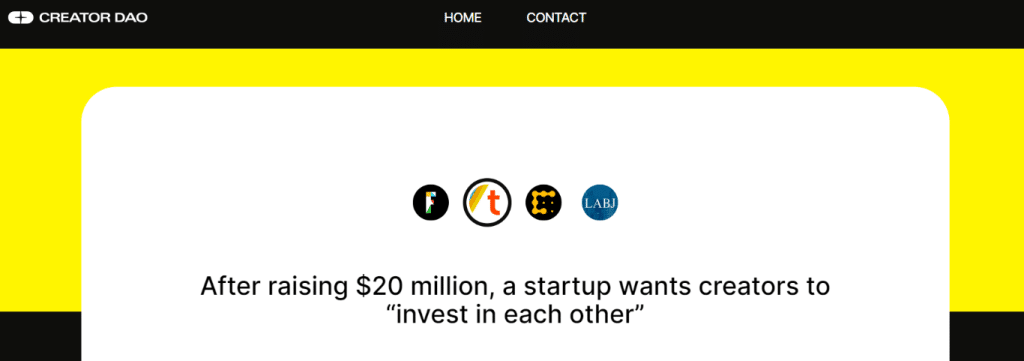
Risks and Challenges Facing DAOs
DAOs have a short history thus far. In some areas, such as the management of decentralized applications, DAOs may offer a superior solution in many cases. But the road ahead could bring some challenges.
- Smart contract vulnerabilities: Topping the list, smart contracts are key to running a DAO but may also carry vulnerabilities that put the treasury and DAO assets at risk. ChainSec maintains an impressive list of DeFi exploits in which massive amounts of money were stolen.
- Regulatory uncertainty: Decentralized Autonomous Organizations exist in a legal grey area, with the actions of some possibly falling within the regulatory scope of government agencies. In the US, only three states recognize DAOs as legal entities alongside traditional legal entities like LLCs and corporations.
- Dispute resolution: Decentralized Autonomous Organizations can vote to resolve many disputes and disagreements. However, some situations may not be as easily resolved through tokenized democracy. With regulatory uncertainty as a backdrop, could DAO founders be found liable in disputes? We’re in uncharted waters in many regards.
- Transaction costs: On blockchains, every transaction costs real-world money. For example, on the Ethereum blockchain, signing a contract to vote or minting a token, for example, requires a network fee paid in ether (ETH). Costs to manage the Decentralized Autonomous Organization and make transactions approved by voters can add up quickly.
Conclusion
A decentralized autonomous organization provides a powerful way to manage projects, invest, or contribute to causes without the top-down structure found in traditional organizations. Today’s highest-profile uses center on the management of decentralized applications and blockchain development initiatives. However, the flexibility of a DAO permits countless other uses, only limited by our collective imagination and, of course, legal constraints.
The DAO movement still has some challenges ahead, particularly in the areas of contract security and regulatory uncertainty. However, the blockchain world has a solid history of finding solutions in ways traditional organizations may not envision.
FAQs
What does DAO stand for?
The abbreviation DAO stands for Decentralized Autonomous Organization. The term refers to an organization that uses blockchain-based voting to decide on changes or initiatives without a traditional management team.
What is a DAO in crypto?
A DAO is a Decentralized Autonomous Organization, a management structure that uses smart contracts for voting on issues and initiatives for the DAO. The DAO structure allows decentralized projects to run without a centralized management team.
What is an example of a DAO?
Uniswap is one of the best-known examples of a DAO. The Uniswap decentralized exchange is managed by holders of the UNI token, who can vote on changes to the protocol.
How does a DAO make money?
DAOs don’t always make money. Some exist to support charitable contributions. However, DAOs use token sales for fundraising. Assets, including cryptocurrencies, held by the DAO may also appreciate in value.
References
- How The DAO Hack Changed Ethereum and Crypto (coindesk.com)
- Reentrancy Attacks and The DAO Hack (chain.link)
- Introduction to Ethereum governance (ethereum.org)
- CRITICAL UPDATE Re: DAO Vulnerability (ethereum.org)
- Why Ethereum Classic? (ethereumclassic.org)
- Uniswap Governance (uniswap.org)
- Lido governance process (lido.fi)
- Arbitrum proposes $85M grant program led by council and advisers (blockworks.co)
- The Maker Protocol: MakerDAO’s Multi-Collateral Dai (MCD) System (makerdao.com)
- ConstitutionDAO (constitutiondao.com)
- About PleasrDAO (pleasr.org)
- GOVERNANCE WITHIN CARDANO (cardano.org)
- Aragon DAO (aragon.org)
- What is the Decentraland DAO? (decentraland.org)
- Governance FAQs (docs.seamlessprotocol.com)
- Proposals (dao.radiant.capital)
- CreatorDAO (creatordao.com)
- Documented Timeline of DeFi Exploits (chainsec.io)
- A Primer on DAOs (harvard.edu)
About Cryptonews
At Cryptonews, we aim to provide a comprehensive and objective perspective on the cryptocurrency market, empowering our readers to make informed decisions in this ever-evolving landscape.
Our editorial team, comprised of more than 20 professionals in the crypto space, works diligently to uphold the highest standards of journalism and ethics. We follow strict editorial guidelines to ensure the integrity and credibility of our content.
Whether you’re seeking breaking news, expert opinions, educational resources, or market insights, Cryptonews.com is your go-to destination for all things crypto since 2017.

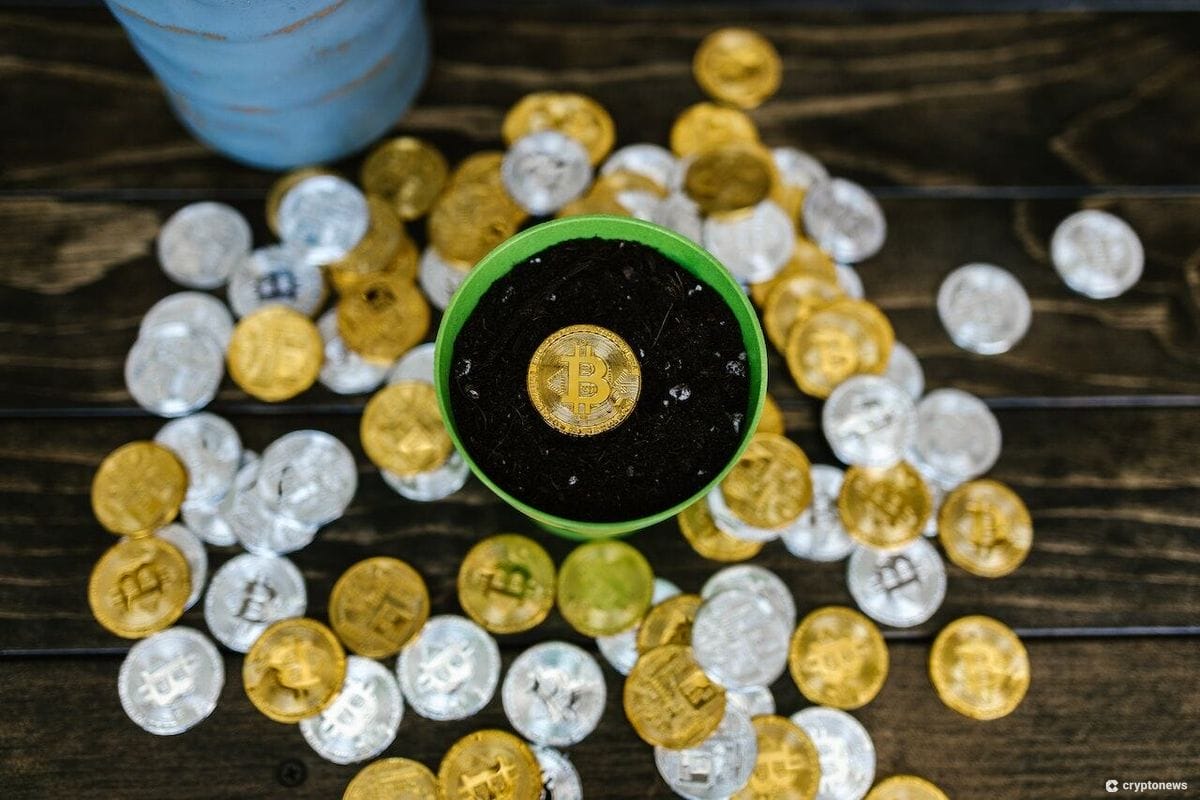
 Connor Brooke
Connor Brooke 
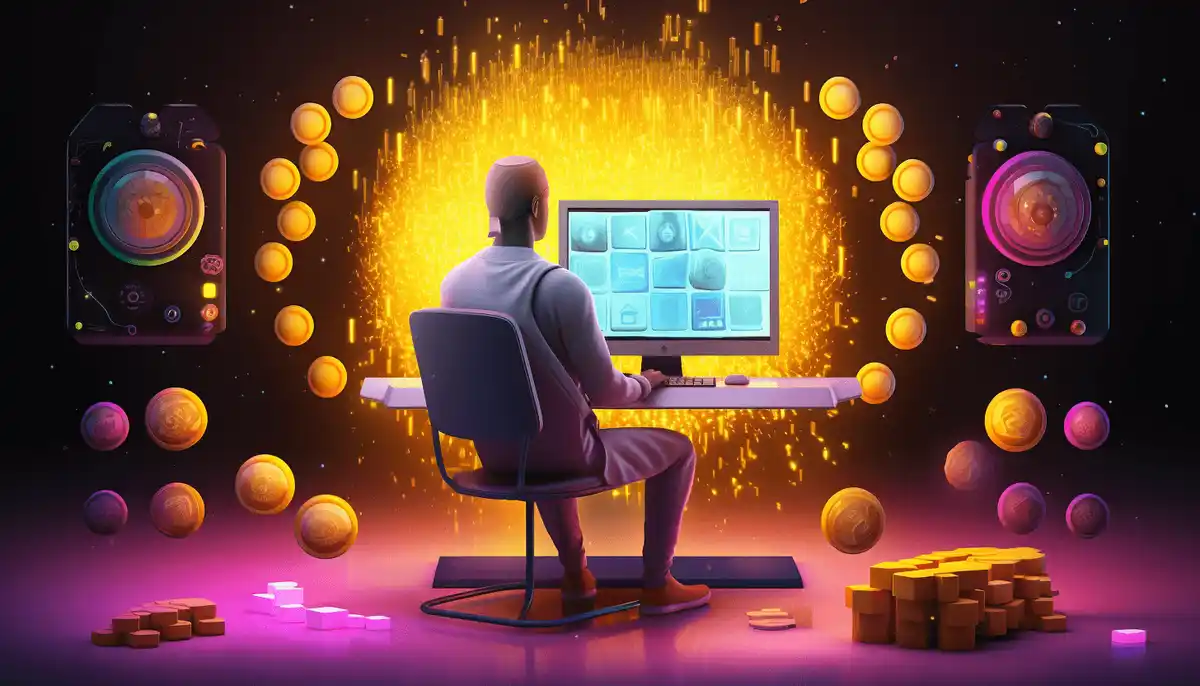
 Nick Pappas
Nick Pappas 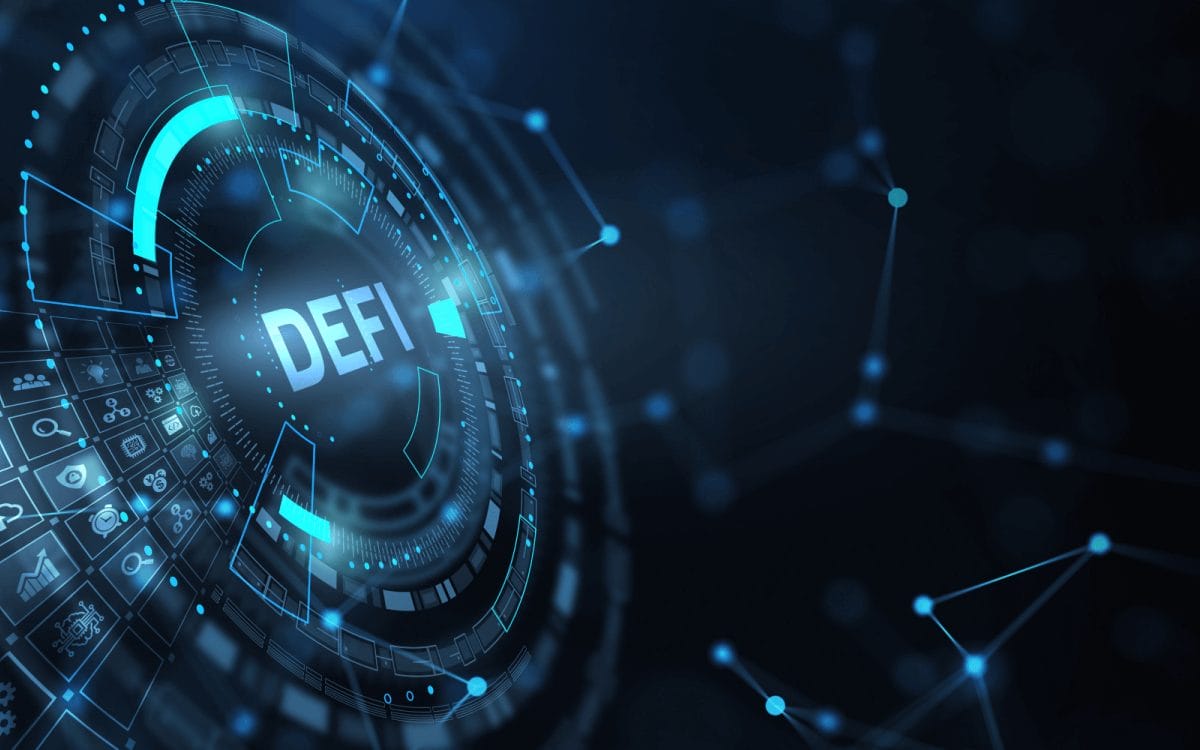
 Eliman Dambell
Eliman Dambell